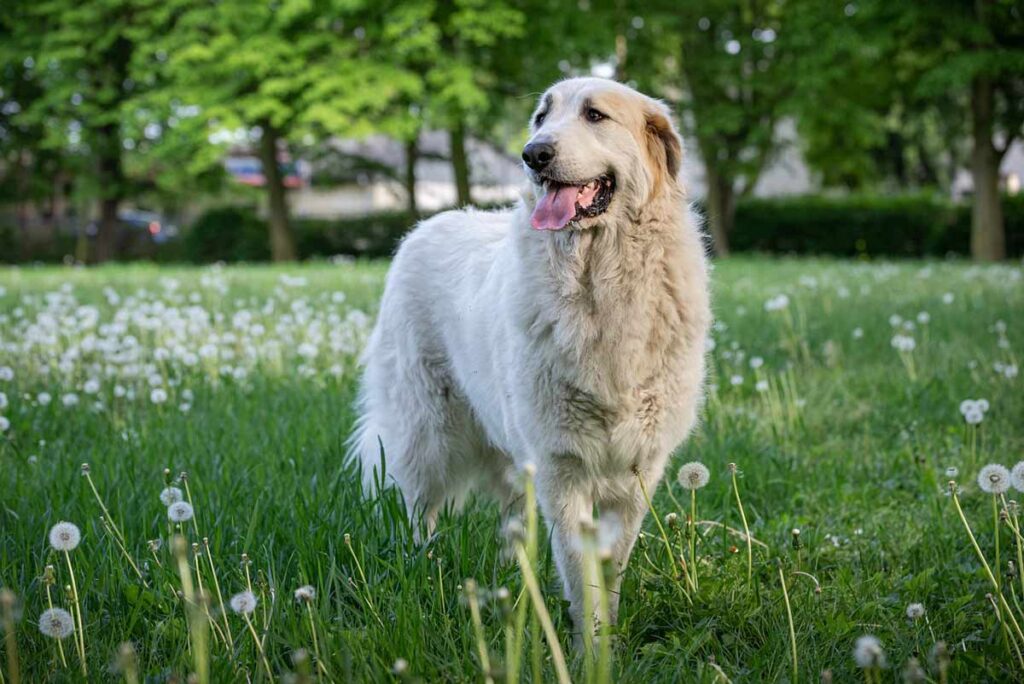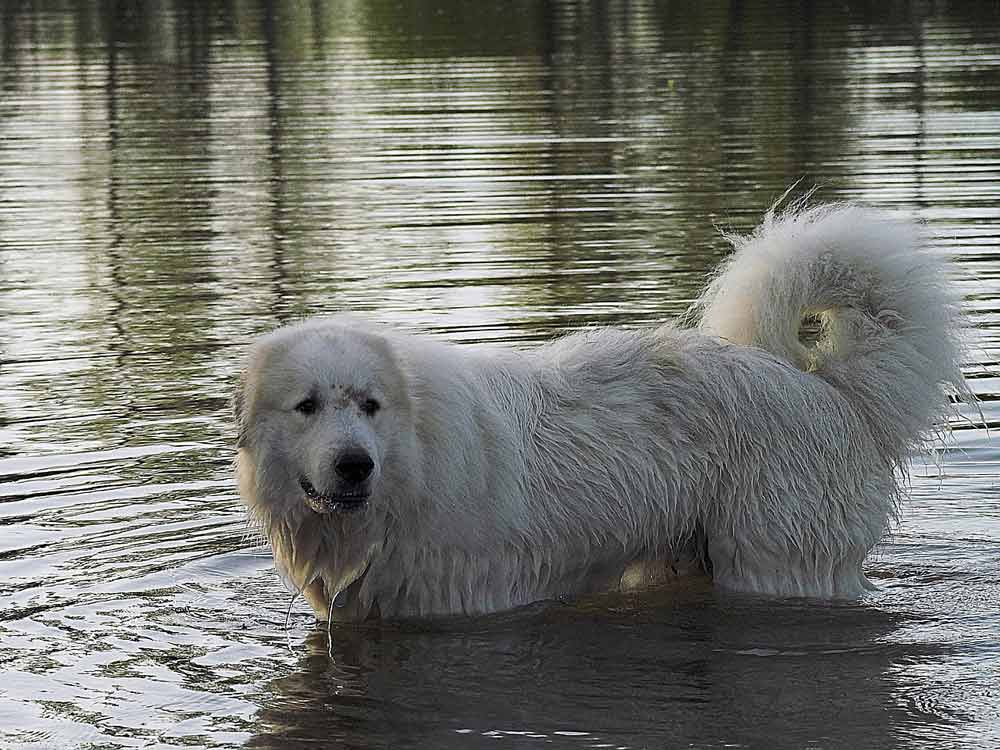
- Home
- Stud Dogs
Some of our most popular Stud Dog Breeds:
- Puppy Litters
- Dog Services
- Dog Breed Profiles
- Blog
- Contact Us
Pyrenean Mountain Dog Breed Profile

Loving, sweet-natured and protective, the Pyrenean Mountain Dog truly epitomises the “gentle giant” of dog breeds. These huge dogs are incredibly people-oriented and love nothing more than to be snuggled up next to a member of their family, employing their characteristic pawing motion to express affection, and to achieve and maintain attention if they feel that it is lacking. Alert and watchful, the Pyrenean Mountain Dog still retains the inherent qualities that served to make it such an excellent guard dog centuries ago. These, combined with this breed’s exceptional care and delicacy towards children and smaller animals, make it a great addition to any household and helps it become the unusually large heart of many families.

Typical Pyrenean Mountain Dog Facts
Height: 27-32 inches (68-80 cm)
Weight: 106-143 lbs (48-65 kg)
Average Litter Size: 6-12 puppies
Life Expectancy: Up to 12 years
Good with Children: Yes
Kennel Club Classification: Pastoral
Colour of a Pyrenean Mountain Dog
Pyrenean Mountain Dogs are predominantly white, sometimes with small patches of tan, grey, orange or lemon on the face or around the tail.

Grooming a Pyrenean Mountain Dog
Pyrenean Mountain Dogs boast impressive coats that were historically essential in the cold climates of the mountains from which they originate. The outer coat is long and coarse and either straight or wavy, while the undercoat is thick, dense and perfect for combatting cooler temperatures. Due to the sheer volume of hair involved, the Pyrenean Mountain Dog does tend to shed quite a lot throughout the year; however, it requires minimal grooming, with a weekly brush to tease out mats and tangles generally proving sufficient.
Pyrenean Mountain Dog Common Ailments/Health Issues
Although Pyrenean Mountain Dogs can and do live long, full lives, this breed is prone to a number of health conditions. These range from skin complaints, such as acute moist dermatitis, demodicosis and Ehlers-Danlos syndrome, to a variety of other issues, including congenital deafness, epilepsy, gastric dilatation-volvulus and hypothyroidism.
Temperament of the Pyrenean Mountain Dog
Faithful, affectionate and gentle, you could be forgiven for thinking the Pyrenean Mountain Dog’s heart is the largest part of its very large body. With their strong protective instincts, great affinity for human contact and particular care towards children, it would be difficult to find a more family friendly breed with which to make your home complete. With this being the case, it is important to remember that Pyrenean Mountain Dogs can suffer with significant separation anxiety and should not be left alone for long periods of time.

Training a Pyrenean Mountain Dog
While the Pyrenean Mountain Dog generally possesses only moderate intelligence, it is quite easy to train. It is typically able to grasp new commands quickly and easily, but its independence sometimes results in less co-operation than might be desired. It is important to approach training in a calm and patient manner, providing a great deal of praise and a reward for every achievement. It is also essential to thoroughly socialise your Pyrenean Mountain Dog at an early age, introducing it to as wide a range of new people, animals and situations as possible to prevent its protective instincts from becoming uncontrollable as it grows.
Exercise for a Pyrenean Mountain Dog
Pyrenean Mountain Dogs are relatively laidback and, as such, do not require a great deal of exercise, with one 30-minute walk each day generally being sufficient to meet their needs in this regard. On the other hand, this breed is prone to roaming and can be quite territorial – a lingering trait from its pastoral days – so, ideally, it should have some outdoor space that it can call its own. That said, Pyrenean Mountain Dogs are also surprisingly good at both jumping and climbing, so any such outdoor space must be securely fenced to prevent escape. It is also important to remember that the Pyrenean Mountain Dog, like many large breeds, do not cope well in higher temperatures, and it is therefore advisable to exercise them during the cooler parts of the day.

History of the Pyrenean Mountain Dog
The roots of the Pyrenean Mountain Dog can be traced firmly back to the Pyrenean Mountains, which separate the countries of France and Spain, although exactly how far back they go is another question. While there are accounts of large, sheep-herding dogs originating in this area dating back over 2,000 years, the first accurate description of today’s version of the breed did not emerge until around the 16th century. Either way, there can be little doubt that the Pyrenean Mountain Dog ranks amongst one of the oldest breeds of dog in Europe, and perhaps the world.
Originally, the Pyrenean Mountain Dog was bred for its attributes as a guard dog and its instinct to protect those smaller and weaker than itself. Its main job was to protect flocks of sheep and herds of cattle, giving chase to and dispatching any predators that sought to attack, including wolves. Indeed, the coat of the Pyrenean Mountain Dog was historically white to help shepherds and farmers to distinguish it from the large mammals against which it was trained to defend.
In 1675, Louis the Grand Dauphin (son of Louis XIV) helped to increase the popularity of the Pyrenean Mountain Dog, which became the preferred guard dog for many of the palaces and castles of France. Over the years, the breed’s prevalence as a loyal family pet began to rise. Up until around the mid-19th century, the Pyrenean Mountain Dog could be categorised into two distinct types, with those found in the Eastern Pyrenees often appearing slighter and smaller than their Western cousins. However, as their popularity rose amongst dog-lovers, the two types seem to have been fused and standardised to create the Pyrenean Mountain Dog we now know and love.
The Pyrenean Mountain Dog played its part during the two World Wars, with its role being to carry messages and supplies between different French troops across the mountains of Europe. Sadly, the breed’s involvement in the warfare resulted in its numbers being severely depleted by the mid-20th century, although it was to be revived once more by the devoted attentions of several determined breeders. Today, Pyrenean Mountain Dogs can still be found guarding livestock in their native France, but they are as likely to be discovered contentedly enfolded in the centre of a loving family home.
Pyrenean Mountain Dog Stud Dog Listings
A dog owner since the early 80s, after convincing his parents to buy a Yorkshire terrier named Sadie, Darren created Dream Dogs so dog owners could find the best dog related information on the Internet.